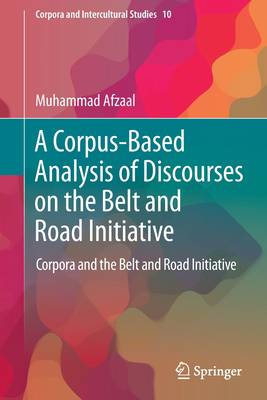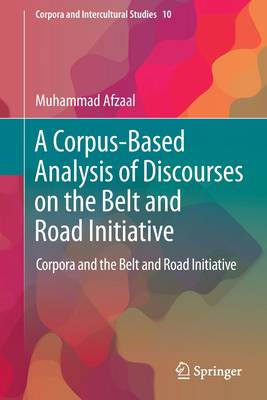
- Retrait gratuit dans votre magasin Club
- 7.000.000 titres dans notre catalogue
- Payer en toute sécurité
- Toujours un magasin près de chez vous
- Retrait gratuit dans votre magasin Club
- 7.000.0000 titres dans notre catalogue
- Payer en toute sécurité
- Toujours un magasin près de chez vous
A Corpus-Based Analysis of Discourses on the Belt and Road Initiative
Corpora and the Belt and Road Initiative
Muhammad Afzaal
198,45 €
+ 396 points
Description
Chapter 1 Introduction 1.1 Research Background 1.2 Research Rationale 1.3 Belt and Road Initiative1.3.1 Belt and Road Initiative (BRI) and China Pakistan Economic Corridor (CPEC) 1.3.2 BRI and China's Neighboring Countries1.4 Significance of the Study1.5 Objectives of the Research 1.6 Research Questions 1.8 Summary Chapter 2 Review of Literature 2.1 Studies on Critical Discourse Analysis 2.1.1 Language, Ideology and Media Power 2.2 Studies on Critical Discourse Analysis and Corpus Linguistics 2.2.1 Critical Discourse Analysis 2.2.2 Faircloughian CDA and conceptualization of power 2.2.3 Corpus Linguistics 2.3 Studies on CPEC and BRI 2.3.1 Pak-China Friendship: Iron Brothers 2.4 Topography of China Pakistan Economic Corridor 2.5 One Belt One Road (OBOR) 2.6 Gwadar Port2.7 Summary Chapter 3 Theoretical Framework and Methodology 3.1 Overview of CDA and CL 3.2 Theoretical Framework of the Present Study3.2.1 Fairclough Three-dimension Model 3.2.2 Corpus-based CDA 3.2.3 Merger of CDA and CL 3.3 Procedures of Data Collection 3.3.1 Corpus for the Study 3.3.1.1. Pakistan English Newspaper Corpus (PENC) 3.3.1.2 Indian English Newspaper Corpus (IENC) 3.4 Software used in the Study 3.5 Keywords and Corpus Techniques 3.6 Summary of Chapter Chapter 4 Perceptions of China Pakistan Economic Corridor and Belt and Road Initiative 4.1 Representation of CPEC in PENC by Frequency items 4.2 Representation of CPEC in PENC by Keywords 4.3 Collocation of 'Iron brothers' and China- Pakistan Alliance 4.4 N-Grams of Targeted words 4.5 Bigrams of Top Twenty Keywords4.6 Collocates and Concordance lines4.7 Top Twenty Collocates in PNEC 4.7.1 Collocates of China Pakistan Economic Corridor (CEPC) 4.7.2 Collocates of CPEC with T-score 4.8 Representation of Belt and Road Initiative (BRI) 4.9 Concordance Lines 4.9.1 Concordance Lines of "CPEC" 4.9.2 Concordance Lines of "BRI" 4.9.3 Concordance lines of 'China' 4.9.4 Analysis of Selected Keywords pertinent to CPEC 4.9.5 Concordance lines of "we" 4.10 Summary of the Chapter Chapter 5 Perception of BRI and CPEC in Indian Newspapers 5.1 Introduction 5.3 Key terms against BNC in IENC 5.4 Biagram of Top Twenty Keywords against BNC 5.5 Concordances of CPEC in Indian sub corpus 5.6 Modifiers of "China" in Indian Corpus 5.7 Concordances of "Threat" in Indian Sub-corpus 5.7.1 Application of "Threat" as a noun co-occurring with modifiers5.8 Concordances of 'We" 5.8.1 Verbs Collocating with "we" 5.9 Concordance of 'China' 5.10 Keywords Against BNC in Indian Sub-corpus 5.11 Representation of BRI by Co-occurring Adverbs 5.12 Summary Chapter 6 Discussions: Similarities and Differences of BRI and CPEC in Media Discourses of India and Pakistan 6.1 Introduction6.2 Comparison of Keyness of PENC and IENC against BNC 6.3 Belt and Road Reshaping the Future 6.4 Geo-Strategic Perspective 6.5 Pak-India Relations
Spécifications
Parties prenantes
- Auteur(s) :
- Editeur:
Contenu
- Nombre de pages :
- 130
- Langue:
- Anglais
- Collection :
- Tome:
- n° 10
Caractéristiques
- EAN:
- 9789811996184
- Date de parution :
- 21-01-23
- Format:
- Livre broché
- Format numérique:
- Trade paperback (VS)
- Dimensions :
- 156 mm x 234 mm
- Poids :
- 217 g

Les avis
Nous publions uniquement les avis qui respectent les conditions requises. Consultez nos conditions pour les avis.






